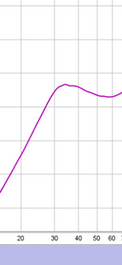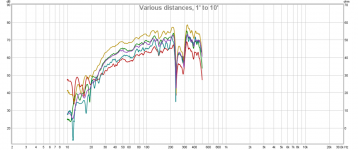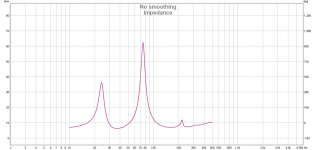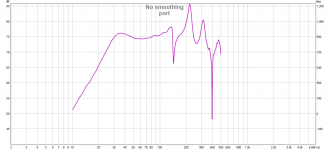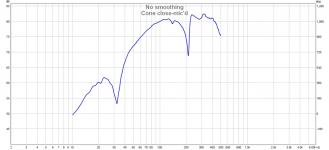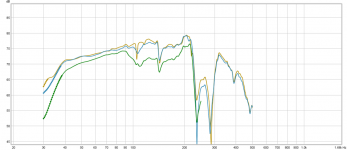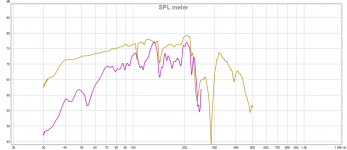As ever Chris thanks for sharing your experiences.
My guess is that REW measures outside the range of frequencies you specify in order that you can subsequently apply averaging to the frequency response graph. For example, if you had measured down to 20Hz, if REW had a measurement down to half of that "up its sleeve" then you could later produce a frequency response graph with one octave smoothing down to 20Hz. Similarly upwards from 20kHz to 40kHz, for example.
Your experiences are interesting and I would suggest probably supporting the fact that it's better to use an MLS signal for high-power testing rather than a swept sine-wave. I'm not sure if REW supports MLS, having not used it. I have used Holm Impulse before which I've found to be excellent, and if I recall correctly that offers the option of MLS or swept sine. I think in future I might be using MLS.
Good luck in getting the reconed driver sorted out. If somewhere is going to charge for that work, they need to do it right - and I'm sure they'll be only too happy to sort it out.
My guess is that REW measures outside the range of frequencies you specify in order that you can subsequently apply averaging to the frequency response graph. For example, if you had measured down to 20Hz, if REW had a measurement down to half of that "up its sleeve" then you could later produce a frequency response graph with one octave smoothing down to 20Hz. Similarly upwards from 20kHz to 40kHz, for example.
Your experiences are interesting and I would suggest probably supporting the fact that it's better to use an MLS signal for high-power testing rather than a swept sine-wave. I'm not sure if REW supports MLS, having not used it. I have used Holm Impulse before which I've found to be excellent, and if I recall correctly that offers the option of MLS or swept sine. I think in future I might be using MLS.
Good luck in getting the reconed driver sorted out. If somewhere is going to charge for that work, they need to do it right - and I'm sure they'll be only too happy to sort it out.
Bit of a development.
I hammered the driver a bit (as much as you can with one side of an EP1500) to loosen everything up a bit and the scraping noise has stopped. Fs is now around 44Hz and the suspension feels more compliant. Not sure what's happened, but I'm glad the problem appears to have passed. The supplier has gone very quiet after I suggested they listen more closely to the video I sent them, which (IMO) clearly shows a scraping sound. There's also some buzzing, which is because of the ground loop between my laptop (plugged into mains) and the amp.
Here's the link, if anyone is interested:
https://www.youtube.com/watch?v=_Il4ia8GP2g
Mark, thanks, I'll do some reading on MLS measurements.
Chris
I hammered the driver a bit (as much as you can with one side of an EP1500) to loosen everything up a bit and the scraping noise has stopped. Fs is now around 44Hz and the suspension feels more compliant. Not sure what's happened, but I'm glad the problem appears to have passed. The supplier has gone very quiet after I suggested they listen more closely to the video I sent them, which (IMO) clearly shows a scraping sound. There's also some buzzing, which is because of the ground loop between my laptop (plugged into mains) and the amp.
Here's the link, if anyone is interested:
https://www.youtube.com/watch?v=_Il4ia8GP2g
Mark, thanks, I'll do some reading on MLS measurements.
Chris
Chris,Bit of a development.
I hammered the driver a bit (as much as you can with one side of an EP1500) to loosen everything up a bit and the scraping noise has stopped. Fs is now around 44Hz and the suspension feels more compliant. Not sure what's happened, but I'm glad the problem appears to have passed.
I had an Eminence 15" that had a hard "click" at around Xmax, at the time (around the turn of the century) I was unsure if Xmax was peak to peak rather than one way, and thought the coil was hitting the back plate- Xmech.
After some use on gigs, and re-testing, the click was gone, and the speaker could do well above Xmax with no "funny business".
I surmise that a bit of glue made it's way into the gap during assembly, and was either "sanded" or knocked out when the driver was run hard, sounds like your driver may have had a similar problem.
Art
So, new driver, same box. Some more measurements for your viewing pleasure...
First up, close-mic'd driver:
For some reason, port tuning has dropped to 30Hz. Go figure. It is a bit colder in here, but 10% is a pretty big shift.
Close-mic'd port:
Next up, I used REW to combine those two responses, dropping the port output by 1.6dB to compensate for the area differences.
Got this:
Very respectable, IMO, for a 15" driver in a tiny box.
Moved the mic a foot away from the cabinet as a sanity-check:
And here's the impedance curve, which is pretty much what you'd expect, except that the minimum point is around 36Hz, whereas close-mic'd driver suggests a 30Hz tuning.
I've played with Hornresp for a bit, and I can't reconcile the two - you can get the impedance to line up, or the LF output to (pretty much) line up, but not both.
I did add some bracing along the back panel and some of the internal panels, so the simulation areas need reducing accordingly, but I wouldn't expect that much of a departure.
I am wondering if I used the EP1500 with the 30Hz filter engaged for the last round of sweeps. This time the filter is definitely bypassed, and I'm certainly getting more right at the bottom end. If this is a true 30Hz box, I'll be very happy. 40Hz target was a bare minimum of LF extension, so getting useful 30Hz out of a box this small is a dream.
Chris
Edit - just thought - the last set of measurements were with the cabinet horizontal, but this set has the cab vertical, port on the floor. Would that lower tuning by 10%..?
First up, close-mic'd driver:
An externally hosted image should be here but it was not working when we last tested it.
For some reason, port tuning has dropped to 30Hz. Go figure. It is a bit colder in here, but 10% is a pretty big shift.
Close-mic'd port:
An externally hosted image should be here but it was not working when we last tested it.
Next up, I used REW to combine those two responses, dropping the port output by 1.6dB to compensate for the area differences.
Got this:
An externally hosted image should be here but it was not working when we last tested it.
Very respectable, IMO, for a 15" driver in a tiny box.
Moved the mic a foot away from the cabinet as a sanity-check:
An externally hosted image should be here but it was not working when we last tested it.
And here's the impedance curve, which is pretty much what you'd expect, except that the minimum point is around 36Hz, whereas close-mic'd driver suggests a 30Hz tuning.
An externally hosted image should be here but it was not working when we last tested it.
I've played with Hornresp for a bit, and I can't reconcile the two - you can get the impedance to line up, or the LF output to (pretty much) line up, but not both.
I did add some bracing along the back panel and some of the internal panels, so the simulation areas need reducing accordingly, but I wouldn't expect that much of a departure.
I am wondering if I used the EP1500 with the 30Hz filter engaged for the last round of sweeps. This time the filter is definitely bypassed, and I'm certainly getting more right at the bottom end. If this is a true 30Hz box, I'll be very happy. 40Hz target was a bare minimum of LF extension, so getting useful 30Hz out of a box this small is a dream.
Chris
Edit - just thought - the last set of measurements were with the cabinet horizontal, but this set has the cab vertical, port on the floor. Would that lower tuning by 10%..?
Last edited:
Chris,For some reason, port tuning has dropped to 30Hz. Go figure. It is a bit colder in here, but 10% is a pretty big shift.
And here's the impedance curve, which is pretty much what you'd expect, except that the minimum point is around 36Hz, whereas close-mic'd driver suggests a 30Hz tuning.
Edit - just thought - the last set of measurements were with the cabinet horizontal, but this set has the cab vertical, port on the floor. Would that lower tuning by 10%..?
The tuning looks to be 36 Hz to me looking at the port output, you could verify by putting a dot on the cone and sweeping sine waves in that frequency range to see the excursion minima.
Proximity to a boundary can lower tuning a little, but only like 1Hz or so.
The roughly 10 dB LF "droop" is what you get with a too-small box, but we knew that going in
Art
Attachments
Art,
The close-mic'd cone output has a substantial notch at 30Hz, which makes me think that's the port tuning.
If I get time tomorrow, I'll drag it outside for a couple of sweeps at a more sensible distance. I don't think close-micing things is helping much, and room problems come in too quickly when the mic moves away.
Chris
The close-mic'd cone output has a substantial notch at 30Hz, which makes me think that's the port tuning.
If I get time tomorrow, I'll drag it outside for a couple of sweeps at a more sensible distance. I don't think close-micing things is helping much, and room problems come in too quickly when the mic moves away.
Chris
As did the port peak output at the same frequencyHi chris661,
Zmin of your impedance plot will show you the system tuning.
Regards,
Djim
With repeated tests, the notch in cone output showed up at 30Hz every time.
Doesn't fit with the impedance curve, doesn't fit with port output. I can see that.
I know what you guys are saying, and I know it applies to pretty much every resonant system I can think of: cone minimum = port maximum = impedance minimum = tuning frequency. It appears that is not the case here, and I'd like to know why.
Tomorrow, weather permitting, I'll drag an amplifier and this cab outside and do things properly. Its possible that the room I last tested in had some weird issues. Moving the mic away from the cab certainly resulted in a very very rough plot (and I've measured rooms before).
Chris
Doesn't fit with the impedance curve, doesn't fit with port output. I can see that.
I know what you guys are saying, and I know it applies to pretty much every resonant system I can think of: cone minimum = port maximum = impedance minimum = tuning frequency. It appears that is not the case here, and I'd like to know why.
Tomorrow, weather permitting, I'll drag an amplifier and this cab outside and do things properly. Its possible that the room I last tested in had some weird issues. Moving the mic away from the cab certainly resulted in a very very rough plot (and I've measured rooms before).
Chris
With repeated tests, the notch in cone output showed up at 30Hz every time. Doesn't fit with the impedance curve, doesn't fit with port output. I can see that.
How does it fit in with the sim'd driver output in HornResp?
Are you measuring the driver's output with the mic an inch or less from the driver's dustcap?
Chris,I know what you guys are saying, and I know it applies to pretty much every resonant system I can think of: cone minimum = port maximum = impedance minimum = tuning frequency. It appears that is not the case here, and I'd like to know why.
Cone minimum excursion occurs at Fb (box tuning frequency).
The cone's deep 30 Hz cancellation dip you have measured is not directly related to Fb, as is obvious from the impedance minima and port output maxima at the 36 Hz tuning, which you can also verify by looking at the excursion.
The visual excursion minima test is really the best verification of Fb, as both port output and impedance variation cover a pretty wide range, while the excursion minima is usually defined over a few Hz range.
Ever since finding some rather gross tuning errors (what I thought should have been a 36 Hz Fb "on paper" later was measured at 50 Hz
Art
Last edited:
Hi Art,
This all seems a little contradictory. I would have thought that excursion minimum frequency is the same as the 30Hz dip I measured. Am I missing something here?
I'm planning on some high-level tests soon, but its a shared house, so it'll have to be when everyone is out. A 15" driver moving 3mm p/p at, say, 40Hz is still quite a lot of noise.
Brian, the mic capsule was within 1/2" of the centre of the cone.
Today I managed to drag everything outside in-between rain showers. My usual image hosting site is down, so pics are attached, hopefully in order.
First up, the measured response with a few different distances between 1' and 10'. Can't remember which is which, but they're all pretty similar anyway.
Next up, impedance. Looks like a 36Hz tuning.
Port output. Maybe 35Hz? Close enough, anyway.
Cone output. 32Hz is the dip.
It's a 3% difference from the port tuning the other methods agree on. Unless I'm missing something (which is entirely possible), the minimum in cone output is the only tuning frequency that matters - below that, it'll flap around. The highpass filter is there to stop it, so will be set according to the 32Hz tuning that's apparent here.
Most of this is academic, though - when I get around to building four of these in plywood, I'll do a few measurements to confirm things before finishing them.
Chris
This all seems a little contradictory. I would have thought that excursion minimum frequency is the same as the 30Hz dip I measured. Am I missing something here?
I'm planning on some high-level tests soon, but its a shared house, so it'll have to be when everyone is out. A 15" driver moving 3mm p/p at, say, 40Hz is still quite a lot of noise.
Brian, the mic capsule was within 1/2" of the centre of the cone.
Today I managed to drag everything outside in-between rain showers. My usual image hosting site is down, so pics are attached, hopefully in order.
First up, the measured response with a few different distances between 1' and 10'. Can't remember which is which, but they're all pretty similar anyway.
Next up, impedance. Looks like a 36Hz tuning.
Port output. Maybe 35Hz? Close enough, anyway.
Cone output. 32Hz is the dip.
It's a 3% difference from the port tuning the other methods agree on. Unless I'm missing something (which is entirely possible), the minimum in cone output is the only tuning frequency that matters - below that, it'll flap around. The highpass filter is there to stop it, so will be set according to the 32Hz tuning that's apparent here.
Most of this is academic, though - when I get around to building four of these in plywood, I'll do a few measurements to confirm things before finishing them.
Chris
Attachments
So, I managed to get the high-level tests done. Remarkably good performance here, from a compression point-of-view.
Here's 3 plots. I did it in my usual way, because I'm stubborn like that:
Aiming for perfect overlays, I increase the digital mixing desk output by XdB, and reduce the mic return by the same amount, so in theory no matter the SPL, we should get a bunch of overlays that sit perfectly on top of each other.
If they start to diverge at high power (ie, reported SPL is lower), we know something's giving up.
The curves are below. Yellow is low power, blue is at -11dB, green is at the onset of amplifier clipping (0dB). I wimped out and set a 36Hz HP filter for that one. Dropping it to 30Hz didn't change much on the SPL plot, but did increase distortion.
I got some weird results from the SPL meter, but the 2nd plot is what the frequency response looks like at that position. I can say that, at clipping, the loudest point was over 130dB in-room. Set to peak-hold, the SPL meter reported similar SPLs for a variety of output settings (124dB at -20dB, but 125dB at -11dB, go figure).
Repeated sweeps suggest 124dB at -11dB to -14dB range, but that's with the big peak at 130Hz being measured. 70Hz is about 7dB down from that peak, so taking 7dB off all the SPL meter numbers makes some sense. That'd be 117dB at -11 to -14dB-ish, so we're looking at just under 130dB maximum SPL, minus the compression that's shown in the first plot, of the order of 3dB.
So can we call this a 126dB box at 70Hz? Looking at the outdoor plots, that'd be 123dB at 35Hz. Sensible numbers, but pretty impressive in action.
Chris
Here's 3 plots. I did it in my usual way, because I'm stubborn like that:
Aiming for perfect overlays, I increase the digital mixing desk output by XdB, and reduce the mic return by the same amount, so in theory no matter the SPL, we should get a bunch of overlays that sit perfectly on top of each other.
If they start to diverge at high power (ie, reported SPL is lower), we know something's giving up.
The curves are below. Yellow is low power, blue is at -11dB, green is at the onset of amplifier clipping (0dB). I wimped out and set a 36Hz HP filter for that one. Dropping it to 30Hz didn't change much on the SPL plot, but did increase distortion.
I got some weird results from the SPL meter, but the 2nd plot is what the frequency response looks like at that position. I can say that, at clipping, the loudest point was over 130dB in-room. Set to peak-hold, the SPL meter reported similar SPLs for a variety of output settings (124dB at -20dB, but 125dB at -11dB, go figure).
Repeated sweeps suggest 124dB at -11dB to -14dB range, but that's with the big peak at 130Hz being measured. 70Hz is about 7dB down from that peak, so taking 7dB off all the SPL meter numbers makes some sense. That'd be 117dB at -11 to -14dB-ish, so we're looking at just under 130dB maximum SPL, minus the compression that's shown in the first plot, of the order of 3dB.
So can we call this a 126dB box at 70Hz? Looking at the outdoor plots, that'd be 123dB at 35Hz. Sensible numbers, but pretty impressive in action.
Chris
Attachments
Chris,Hi Art,
This all seems a little contradictory. I would have thought that excursion minimum frequency is the same as the 30Hz dip I measured. Am I missing something here?
Next up, impedance. Looks like a 36Hz tuning.
Port output. Maybe 35Hz? Close enough, anyway.
Cone output. 32Hz is the dip.
It's a 3% difference from the port tuning the other methods agree on. Unless I'm missing something (which is entirely possible), the minimum in cone output is the only tuning frequency that matters - below that, it'll flap around.
Yes, it seems you are missing that the 30Hz response dip in cone output you measured, which then went up to 32 Hz, is not at the excursion minima, Fb.
Once you do the excursion sweep and see the cone "stand still" at 35-36 Hz you won't be "missing something" any more
 .
.Cheers,
Art
Chris,
Yes, it seems you are missing that the 30Hz response dip in cone output you measured, which then went up to 32 Hz, is not at the excursion minima, Fb.
Once you do the excursion sweep and see the cone "stand still" at 35-36 Hz you won't be "missing something" any more.
Cheers,
Art
Art,
In that case, there's some (serious) gap in my understanding. Surely a notch in level at the cone is the same as an excursion minimum? After all, displacement and output have some proportionality.
If not, why might the two be different?
I really don't get this at all, which is a little frustrating.
Running a sim in Hornresp seems to back me up on the excursion minimum thing, couple of screenshots below:
An externally hosted image should be here but it was not working when we last tested it.
An externally hosted image should be here but it was not working when we last tested it.
An externally hosted image should be here but it was not working when we last tested it.
Cheers
Chris
Sounds like what you built is not what you modeled.
I'm not quite sure you understand what I'm saying.
Allow me to rephrase:
- When doing a sine sweep with the mic 1/2" away from the 15" cone, there is a severe dip in measured output at 32Hz.
- When playing sine tones, the cone is observed to be still at around 38Hz, with increased excursion at 35Hz and below, as well as 40Hz and above.
- The impedance curve suggests a ~38Hz tuning frequency.
These are all measurements of the same cabinet in the same conditions.
Now, I thought the first statement would indicate the tuning frequency.
I would also have thought that the second statement would indicate the tuning frequency. The third statement supports the second.
The tuning frequencies reported by the two (seemingly very similar) methods are quite different, and I have no idea why.
Moreover, when using Hornresp, with whatever close-enough sim we might choose, the notch in cone output appears to be at the same frequency as the cone excursion minimum in that same simulation. The impedance curve also lines up.
This is again at odds with my observations, that the notch in cone output and the excursion minimum are at different frequencies for this design.
If anyone could shed some light on the matter I'd be very interested, since I have very little idea of what's happening here, but I'm finding it quite frustrating.
Cheers
Chris
- Status
- This old topic is closed. If you want to reopen this topic, contact a moderator using the "Report Post" button.
- Home
- Loudspeakers
- Subwoofers
- Teeny tiny PA 15" subwoofer
